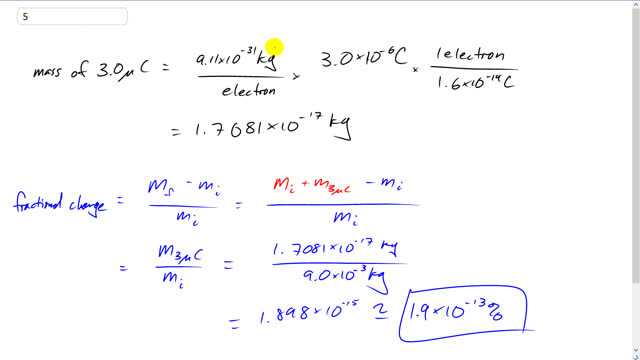
When an object such as a plastic comb is charged by rubbing it with a cloth, the net charge is typically a few microcoulombs. If that charge is , by what percentage does the mass of a 9.0-g comb change during charging?

In order to watch this solution you need to have a subscription.
This is Giancoli Answers with Mr. Dychko. First, we need to figure out what is the mass of three microCoulombs. So we take 9.11 times 10 to the minus 31 kilograms per electron. And I know I had to write this fraction this way instead of electrons per 9.11 times 10 to minus 31 kilograms, because I want this to end up being kilograms. So let's make sure kilograms is in the numerator of this fraction here. And then we'll multiply by 3.0 times 10 to the minus six Coulombs, which get converted into electrons but multiplying by one electron for every 1.6 times 10 to the minus 19 Coulombs. And the Coulombs cancel, leaving us with electrons here, and then these electrons cancel with these electron units there, giving us kilograms in the end. So the mass of one kilogram times 3.0 times 10 to the minus six Coulombs, and then divided by 1.6 times 10 to the minus 19 Coulombs, and we get 1.7 times 10 to minus 17 kilograms is the mass of three microcoulombs. And so the fractional change in mass of the cone is going to be the cone's finals mass minus this initial mass divided by its initial mass. And the final mass would be the initial mass of the cone before it has the electrons added. And then plus the three microcoulombs that we just figured out before. And so that total is the final mass then minus initial mass divided by initial mass. Just copy it from here. And we have initial mass minus initial mass on the top. That makes zero, leaving us with only this term left over, the mass of three microcoulombs. So we take that 1.7081 times 10 to minus 17 kilograms that we found before divided by 9 grams which is nine times 10 to minus three kilograms. And we get 1.898 times 10 to minus 15. That's the fractional change, multiply it by a hundred and round it up to 1.9. That makes 1.9 times 10 to minus 13 percent after you multiply it by 100.
I got 1.708x10^-55
Hi dennis.colon.jr, thanks for the comment. I can't see where the mistake is to arrive at the figure, but I've doubled checked that the answer I've provided is correct. If you have a more specific question about the solution, just let me know.
All the best,
Mr. Dychko
How are you supposed to know that the comb gained (rather than lost) electrons? I know that the chapter mentions that plastic items develop negative charges when rubbed, but I thought the problem would specify that the charge acquired was -3 microcoulombs if the comb had gained (vs. lost) electrons?
Thanks,
Julia
Hi julia.wolfe,
I think the question would be worded better if it said . I don't think you're meant to know that plastic gains electrons, although in this case, without the question specifying a negative charge, knowing the properties of plastic is the only way to know. I would presume that in any real test question that the negative sign would be given.
All the best,
Mr. Dychko
where does the 9.11x10 raised to -31 came from? for future reference please explain when inserting a numerical input that does not appear in the given problem. thanks